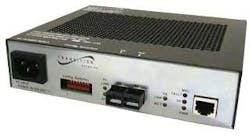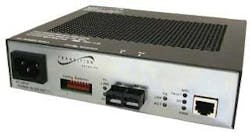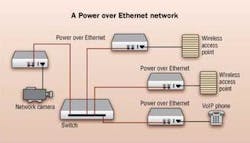A year or two ago, if you asked a network installer whether a power cable and a data cable could be run in the same conduit, the answer most assuredly would be no.
Today, the answer is quite different.
With the emergence of Power over Ethernet (PoE), power and data can run on the same four-pair Category 5, or better, cable. The driving force behind this change is the IEEE standard 802.3af, which defines how devices can be made to supply and accept power over data cable. The standard's goal is to provide a wide range of benefits concerning cost, network simplicity, packet-based efficiency, and remote management.
Often referred to as inline power, PoE is sometimes misconstrued as powerline or homeplug technology that uses electrical wiring to transport data. But PoE enables electrical currents of an end device to be carried by the data cables rather than by power cords within the wired LAN environment.
The 802.3af Power over Ethernet standardization project began in 1999 and was ratified last June. Unfortunately, due to its long standardization process, many products claimed early on that they were PoE-compliant before the standard was final. Therefore, users of early-adopter products will need to assess their requirements and compare manufacturers' products before relying on them network-wide. For the most part, recently designed products comply with the final standard, and users should feel comfortable integrating them into their networks.
For many network users, PoE offers advantages such as easier and greater flexibility for equipment installation, less downtime, and lower costs than running individual wiring for power. The standard lets network planners minimize the number of wires that must be strung to install some of the equipment on the network. The emergence of 802.3af also offers new solutions for other common problems, such as running data and power to remote locations with a low density of devices.
The components of Power over Ethernet
Power over Ethernet is supported by two devices defined by the standard: the power source equipment (PSE) and the powered device (PD). The PSE provides the power and the PD accepts the power. An example of PSE is the midspan hub, such as a 10/100 switch that is PoE-capable. Examples of a powered device could be a VoIP phone, a security camera, or a wireless access point.
For PoE to work, the electrical current must travel on a standard Category 5 or better Ethernet cable. A Category 5 cable has four twisted pairs, but only two of the pairs are used for data speeds up to 100 Mbits/sec. The 802.3af specification allows either the spare pairs (pins 4-5 and 7-8) or the data pairs (pins 1-2 and 3-6) to be used to carry the power.
Note that some manufacturers may implement only one option for providing the power, while other manufacturers may support both. Check the devices' specifications carefully before purchasing to ensure all components are compatible.
Four-pair cable is required by the standard. A PSE provides a maximum of 15.4 watts of power at -48V DC and a PD can have a maximum input power requirement of 12.95 watts. This difference accounts for the degradation of power over the length of the cable.
Another device on the market similar to 802.3af products is a midspan injector, which combines data and power, and transmits its signal over data cable. A network manager must be cautious, however, because unlike an 802.3af-compliant device, a midspan injector does not verify that the end device it is supplying is a PD. The 802.3af standard requires PSEs to make such verification and to verify the PD's capability, thus preventing damage from occurring to non-PD devices.
Another area of caution is that the power that midspan injectors supplies is not standards-based, and should be verified before powering an end device to ensure compatibility.
PoE's sweet spot
Even though PoE or 802.3af is a fairly new standard, several manufacturers have developed PSEs or PDs, or both. Most major Ethernet switch manufacturers offer PoE capabilities. There are also a large many producers of wireless access points, Voice over IP phones, and security cameras for the PDs.
The sweet spot for PoE lies in three of the hottest segments in technology today: Voice over IP, 802.11 Wi-Fi wireless networks, and security. The growth of VoIP services is increasing rapidly in the business world, and network managers are deploying this technology for major cost savings. PoE technology is one of the new standards that will allow VoIP to be rolled out more readily, eliminating the need to have an external power supply for the VoIP phone.
Most users are accustomed to having the phone powered by the phone line. With PoE, however, new VoIP phones can have the same look-and-feel, and easier installation and management for network managers. For high-density applications, such as large VoIP installations, a network manager can establish a local data room and deploy a Power over Ethernet switch within 100 meters of a batch of phones.
Extending PoE capabilities
Many other applications for PoE are not governed by a nearby power source, which implies that they are not near a data room. Using the PoE standard alone limits the location of the device to within 100 meters of a data room; however, with added technologies, network managers can increase the remote-location distance and still maintain network quality and reliability.
An alternative for running data and power out to remote devices is to incorporate a Power over Ethernet media converter into the network, combining the benefits of media conversion with the benefits of 802.3af.
A media converter is a physical-layer device that converts one media type to another media type-typically, copper to fiber. These devices are used for network extension over optical-fiber cable. With a Power over Ethernet media converter, network managers can use current data centers to run fiber to a PoE media converter; the device then converts the data from fiber to copper, adds power, and transmits it to the PD.
Using a PoE media converter provides a network manager with more options when deploying new technologies. One example is a company deploying a wireless network in an office or a large warehouse:
Wireless access points must be deployed throughout the facility to ensure complete coverage for reliability. The network manager likely will incur the need to extend beyond the 100 meters of the copper cable to reach many of the wireless access points. Fiber is run from a data room to an area with access to power; the PoE media converter can be powered by either 48V DC or standard 100 to 240V AC power. The converter is attached to the power supply, the fiber cable is attached to the converter, and then unshielded or shielded twisted-pair cable can be extended another 100 meters to the wireless access point.
A network manager can incur similar problems when installing security cameras because they are typically placed in remote locations. Again, the network manager can take advantage of media conversion by extending the reach of the data room with fiber, converting the signal back to copper, adding power, and connecting the camera to the network. (This only applies to IP cameras that are PDs.)
The same application can be used with VoIP phones, but may not be as attractive to network managers who are considering the density of VoIP users. It may be more cost-effective in this case to install a small data room with an Ethernet switch that is a PSE.
PoE today
After all the debating, testing, probing, and retesting, the Power over Ethernet standard is final. Having a standard define the properties of a product provides end users with confidence when they are rolling out a network. It also lets end users mix and match different manufacturers' equipment, and be assured that it will be compatible so they won't be locked into a proprietary solution.
There may be only a small number of applications for Power over Ethernet devices, but with the ratification of the standard, the uses and the number of Power over Ethernet devices being manufactured are rapidly expanding.
PoE technology provides new solutions to some old problems, and lets technologies be deployed en masse. Having a standard means users can deploy Power over Ethernet systems with confidence.
PoE technology provides new solutions to some old problems, and lets technologies be deployed en masse. Having a standard means users can deploy Power over Ethernet systems with confidence.
BILL SCHULTZ is vice president of Transition Networks (www.transition.com).

